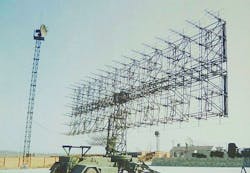L-3 and Northrop Grumman to upgrade prototype Navy low-band jammers to foil enemy anti-stealth radar
PATUXENT RIVER NAS, Md. – U.S. Navy aerial electronic warfare (EW) experts are asking two prime defense contractors to improve components of experimental low-band tactical RF jammers intended to enable Navy EA-18G Growler carrier-based aircraft to foil enemy counter-stealth radar systems.
Officials of the Naval Air Systems Command at Patuxent River Naval Air Station, Md., have announced plans to award contract modifications to L-3 Technologies Communications Systems-West in Salt Lake City, and the Northrop Grumman Corp. Mission Systems segment in Bethpage, N.Y., for the Next Generation Jammer Low Band (NGJ-LB) program.
The NGJ-LB program is an urgent effort to develop low-band tactical radar jammers using existing technologies for low size, weight, and power consumption (SWaP) applications on the EA-18G Growler EW jet. The value of the upcoming contract modifications have yet to be negotiated.
The effort is called NGJ-LB Increment 2 Demonstration of Existing Technologies (DET), and aims to increase the Navy's knowledge and understanding of existing technologies able to support an airborne wideband low radio frequency (RF) band jamming application where significant SWaP and cooling constraints exist, such as those on the EA-18G.
Related: Electronic warfare evolves to meet new threats
EW experts at L-3 and Northrop Grumman will expand their analyses and design NGJ-LB controller, receiver, exciter (CRE), and power generation subsystems to carry out updated Navy program goals. L-3 and Northrop Grumman won a $35.8 million contract and a $35.2 million contract, respectfully, last October.
Low-band anti-stealth radar can be useful for detecting stealth aircraft like the U.S. F-35 joint strike fighter and B-2 bomber, and is needed urgently for the EA-18G, which virtually is the only dedicated electronic warfare aircraft in the U.S. inventory.
L-3 and Northrop Grumman also are helping the Navy use open-systems architectures -- particularly the ability to upgrade tactical jammer subsystems easily -- to enhance the long term system viability of a future low-band tactical jammer -- and upgrade the system as necessary to keep pace with evolving threats. Navy officials say they want to develop and field a SWaP-optimized low-band tactical airborne jammer as soon as feasibly possible.
The contractors will help the Navy determine the milestone entry point for introducing low-band tactical jammer technologies to the Next-Generation Jammer, which is to replace the aging ALQ-99 tactical jammer on the EA-18G aircraft for airborne electronic attack.
Related: The new world of counter-drone technology
The goal is to develop system-level alternatives for the best possible maritime electronic warfare capabilities, while making the most of existing and projected technologies.
Specifically, L-3 and Northrop Grumman will demonstrate a low-SWaP transmitter in a pod that will fit on Station 6 of the EA-18G; enhance the performance of frequency coverage, effective isotropic radiated power, spatial coverage, spectral purity, and polarization; obtain existing contractor data related to transmitter group performance; and assess the potential to deploy an open-systems interim pod solution rapidly.
The Navy will demonstrate these technologies on station 6 of the F/A-18E used as a surrogate for the EA-18G aircraft at Patuxent River NAS for antenna and radar cross section measurement.
For more information contact L-3 Communications Systems-West online at www2.l3t.com/csw, Northrop Grumman Mission Systems at www.northropgrumman.com.
Ready to make a purchase? Search the Military & Aerospace Electronics Buyer's Guide for companies, new products, press releases, and videos

